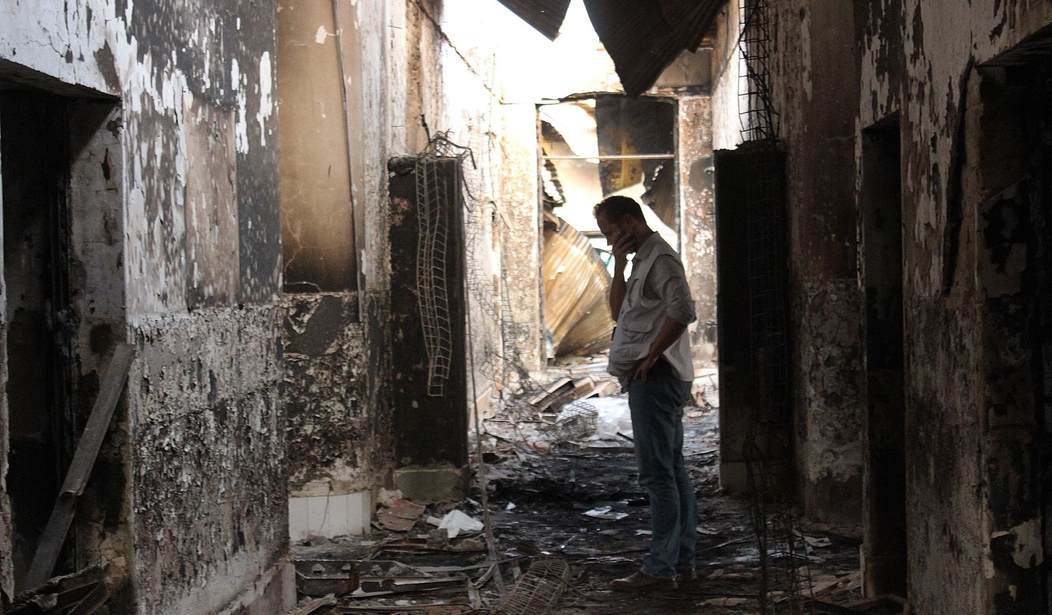The commander of Resolute Support said a series of fatal errors on the part of U.S. forces in Afghanistan led to the Oct. 3 strike on a Doctors Without Borders (MSF) hospital in Kunduz that killed 30 staff, patients, and assistants and wounded 37.
Revealing the results of an internal investigation this morning, Gen. John Campbell stressed that “no nation does more to avoid civilian casualties,” but in this instance the U.S. horribly failed in a “tragic but avoidable accident caused mostly by human error.”
Campbell said that in addition to the U.S. investigation NATO will release its own report. The general spoke earlier with MSF and Afghan leaders about the results of the American probe.
“Those individuals most closely associated with the incident have been suspended from their duties,” he said, pending further disciplinary review.
The Taliban attacked Kunduz on the evening of Sept. 27, and within 24 hours Afghan forces had withdrawn. On Sept. 29, MSF sent their coordinates to the appropriate coalition authorities; those were received and distributed. U.S. special ops forces “rapidly deployed,” and by the time of the hospital strike had been in the city “longer than intended,” fighting five consecutive days and nights.
Campbell said U.S. forces “did not know” the MSF hospital was a trauma center as it was “misidentified” by personnel “who thought they were striking a nearby building.”
A “clearing operation” had been launched the night of Oct. 3, and the target was a headquarters building occupied by insurgents 300 meters away. From the point of that decision, “multiple errors occurred that ultimately resulted in misidentification of and strike on” the MSF compound.
U.S. soft command was located in the provincial police compound in Kunduz. Campbell said they provided correct coordinates of the building that was the intended target, but when those were entered into a system “several miles beyond normal orbit” the “sensors were degraded” and instead pinpointed an open field 300 meters away from the target. So they picked the closest building to the open field.
“Tragically, this misidentification continued throughout the remainder of the operation,” Campbell said, adding that the “crew remained fixated” on the hospital as the target even when technical systems aligned at a different altitude.
The general said they did not observe hostile activity and the decision to strike relied on information from Afghans. Still, he added, U.S. soft command lacked the authority to strike. One minute prior to launching the attack, coordinates were transmitted to a center that had access to the no-strike list but no one caught the match.
The strike began at 2:08 a.m. At 2:20 a.m., coalition authorities received call from MSF reporting they were under attack. It took the commander until 2:37 a.m to realize the mistake, Campbell said. By that time the attack was over. “This is an example of human and process error.”
Cambpell blamed a number of factors for the deadly errors, including fatigue, “high operational tempo,” the temporary loss of electronic communication systems, the nature of the strike planning, and the lack of process to vet targets against the no-strike list.
“We have learned from this terrible incident,” he said, adding that the U.S. “would never strike a hospital.”
The general noted that the coalition is in the process of locating all who were injured in the strike or whose relatives were killed. The U.S. also will offer assistance to MSF to rebuild their hospital in Kunduz, Afghanistan’s fifth largest city.
Doctors Without Borders is still calling for an independent investigation.
“The view from inside the hospital is that this attack was conducted with a purpose to kill and destroy,” said Christopher Stokes, MSF general director, after releasing their own investigation earlier this month. “But we don’t know why. We neither have the view from the cockpit, nor the knowledge of what happened within the U.S. and Afghan military chains of command.”
On Monday, the group released the bios of its staff killed in the strike: patient information specialist Abdul Maqsood, hospital custodian Abdul Nasir, nurse Abdul Salam, deputy medical director Abdul Satar Zaheer, emergency room doctor Aminullah Bajawri, nurse Lal Mohammad, intensive care unit doctor Mohammad Ehsan Osman, nurse Mohibullah, emergency room cleaner Najibullah, ICU nurse Naseer Ahmad, guard Shafiqullah, pharmacy worker Tahseel, guard Zabiullah, and ICU nurse Ziaurahman. (Many Afghans go by one name.)
House Armed Services Committee Chairman Mac Thornberry (R-Texas) said Campbell had briefed lawmakers on the investigation with “candor.”
“It is clear that process failures on multiple levels were involved,” Thornberry said. “We will continue to oversee the investigation as it proceeds, and work closely with our forces in Afghanistan to ensure this tragedy is not repeated.”
Gen. Wilson Shoffner, the deputy chief of staff for communications in Afghanistan, confirmed that “some individuals have been suspended from their duty positions” and “some involved did not follow the rules of engagement.” Possible additional investigations would be made public upon completion and redactions. “We have a responsibility to ensure due process for those involved.”
“We did not intentionally strike the hospital,” Shoffner told reporters. “We are absolutely heartbroken over what happened here.”
All personnel in Afghanistan were getting a training refresher on targeting as well as the rules of engagement.
“We’re determined to learn the right lessons from this and we’re committed to ensuring that this doesn’t happen again,” Shoffner said. “…We would never, ever do anything to harm innocent civilians.”








Join the conversation as a VIP Member